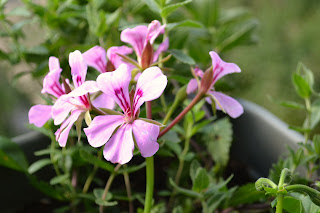
This color entry focuses on the bolder tones in my garden - the reds, oranges and yellows. Most professionals would criticize my overabundance of color and suggest that I stick to a couple of common themes, and believe me I tried. But, I was also intrigued by a number of bold colored flowers that I just had to try, and on a 5x5 space, you are bound to run into some color clashing. At the same time, this porch is just for fun and allows me to experiment for when I am ready to have the large and luscious gardens attached to a house, which probably will be a bit more organized when it comes to color, height and timing.
Reds
You are more likely to find me wearing red to a Badger game, than planting it in my garden, but this year saw a couple of exceptions. I just couldn't resist experimenting with the mandevilla and the fun bonfyre begonia, both of which only came in red.
Bonfyre Begonia - like an exploding firework on the 4th of July, this begonia thrived when I transplanted it from its original hanger to the base of the clematis. It shoots its fun flowers over the sides of the deck and makes a bold statement.

Mandevilla - This tropical climber thrives in humid settings, and was probably a bit risky for moody Wisconsin. A cold June set this one on a slower start, and it didn't really produce a lot of vines. However, it still produce a number of wonderful red flowers, which gradually lighten to pink with age.

Painted Tongue - a multi-colored gem that has already gotten a lot of attention on this blog for its tiger lily like markings. One of its many colors included this red variety with yellow markings. McDonalds, anyone?

Oranges
Black-Eyed Susan Vine - Last year's clear winner was this year's ultimate failure. It just never took off. It maybe produced one flower (expertly captured here), but was ultimately a disappointment. It's not even alive right now. I thought I could spark some energy by removing its trellis, but I only stunted it even more.

Flowering Maple (aka Ablution) - This flower takes its names from its leaves, which resemble the leaves of a maple tree. The flowers are a delicate salmonly orange. The variegated leaves were one of my husband's favorites, showing a yellow and chartreuse camouflage pattern. At this point in the season, it has basically overrun its box mates, so it may have better off in its own pot.


Yellows
Portulaca (aka Moss Rose) - This ugly duckling finally bloomed into a beautiful swan. In June, it had a close resemblance to Bob Marley's head, but this August it finally produced beautiful buttercup like yellow flowers. The only trick is that they seem to open and close throughout the day and I haven't been able to catch them with the buds open.

Canna - I purchased this yellow canna on a very hot day in July at the Madison Farmer's Market. It is a water lover, and I've heard that it can come back next year if I make cuttings in the fall. For now, I just appreciate its constant blooms and tiger pattern.


Painted Tongue - yellow flowers with light yellow markings were also one of the many colors that bloomed from this wonder.















































